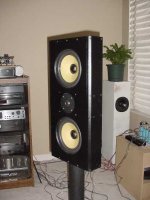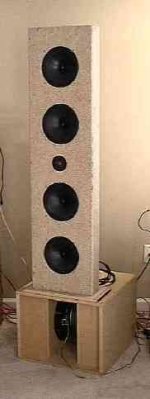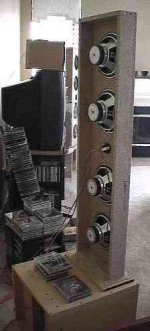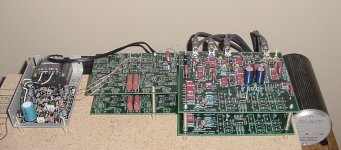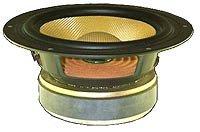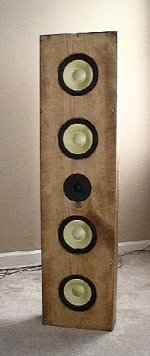Comparisons should be made with real word : top of the top of..What ?!? Top performer with top instruments like Stradivari or beautiful voice ,powerful drummer and so on?
As it has been written several times , everything is a compromise...also dollar and euro are not stable...so YMO it is better to focus of what (scientific: and how) approaches to our definition of perfectness. Went to a local theater some months ago and I think I heard for the very first time a pair of Altecs ;well,that's hi-fi. Scaled to your apartment and with modern techniques ,with your personal requirements in terms of beaming,power,reconstruction of the scene , it is a job. Some may be satisfied by a fullrange (15" of course),some may try 5 ways with the aid of a computer and a mic or even two ways with a particular iperbolical-elliptical shaped horn .The final craft still will have to match with the idea of what we have of a well reproduced sound.
As it has been written several times , everything is a compromise...also dollar and euro are not stable...so YMO it is better to focus of what (scientific: and how) approaches to our definition of perfectness. Went to a local theater some months ago and I think I heard for the very first time a pair of Altecs ;well,that's hi-fi. Scaled to your apartment and with modern techniques ,with your personal requirements in terms of beaming,power,reconstruction of the scene , it is a job. Some may be satisfied by a fullrange (15" of course),some may try 5 ways with the aid of a computer and a mic or even two ways with a particular iperbolical-elliptical shaped horn .The final craft still will have to match with the idea of what we have of a well reproduced sound.
how do you actually KNOW your design sounds better than a similarly-priced commercial product?
Well you are assuming we are all building current designs or speakers using current philosphies. I built an active DIY set-up. There are no commercial speakers on the market that would be a good fit to compare them too. I ended up building a pair of JBL 4344 Large format monitor clones to compare and use a reference system. I actually have built 3 reference systems to compare DIY systems too that are all clones of commercial systems. It's just as much fun building the clones as it is going on your own so why not.
Obviously, anything that you just spent the 50+ hours of your life working on is going to sound spectacular to you.
That one of the reasons to have a reference system available to compare too. I have spent hours on stuff, powered it up, and either scraped the idea or made changes. With a reference you find out real fast if you are on the right track. I have yet to build something and have it stay as is, the only exception would be the clones.
Do they sound better well in some ways yes in others no. I happy with them anyway once I am done.
Rob🙂
Pass builds speakers?
Electronics is a whole new ball game (This is a speaker forum too) and I have to disagree that pass or firstwatt offer true value in terms of performance/$$$ considering the price tag of their equipment.
OK, point taken. Although Pass does build speakers (Rushmore), I agree the value/$ for the Rushmore is less than DIY, but the level of complexity is very high.
I'll speak highly in favor of DIY speakers. I built the Linkwitz Labs Phoenix and the performance is excellent. The commercial equivalents are the Audio Artistry Dvorak (or Signature, depending on how you build it), which costs more than 2x compared to DIY (depending on which DIY raw drivers you buy. Seas and Scan-Speak are expensive!)
I even made a couple versions of the Phoenix, including one using ultra-cheap closeout drivers from Parts Express. They sounded awesome (photos) for the value, easily beating commercial offerings (until I burned out a voice coil, in which the closeout driver is irreplaceable). Remember, the Phoenix uses a complicated electronic crossover, so the expense is still high to build DIY versions, even with cheap drivers. How do I judge the sound quality? I have a pair of Triangle Acoustics Solaris monitors, a pair of Magnepans, and the Definitive Technology Celsius. My buddy has a pair of Martin-Logans Sequence II that we also use as comparison purposes.
IMHO, the DIY Phoenix is the best sounding of the aforementioned commercial speakers that I use as comparisons.
I also use a set of Phoenix dipole woofers to supplement my Triangle Acoustics Solaris in bi-amp configuration. Since there are very few commercial dipole woofers, DIY was the only feasible way to achieve my goals. The Solaris a high-end monitor, comparable to the other very high-end monitors reviewed in Stereophile, etc. The DIY dipole woofers are wonderful with the Solaris.
My message regarding Pass is that sometimes niche-market commercial companies - with Pass representing electronics - can represent innovation usually seen only in the DIY space.
Attachments
Last edited:
...
I even made a couple versions of the Phoenix, including one using ultra-cheap closeout drivers from Parts Express. They sounded awesome (photos) for the value, easily beating commercial offerings (until I burned out a voice coil, in which the closeout driver is irreplaceable). Remember, the Phoenix uses a complicated electronic crossover, so the expense is still high to build DIY versions, even with cheap drivers
...
Do you by any chance have documented this project somewhere? Looks very interesting!
I used to have a fairly comprehensive website documenting the project, but lacked time for maintenance. The Linkwitz web site has a wealth of information: Linkwitz Lab - Loudspeaker Design
Linkwitz details much of the design philosophy. I highly recommend buying the printed circuit boards for the crossovers (photos below) - DIY circuit boards will cost about the same and involve a lot of work.
You can use Vifa, Scan-Speak, or Seas drivers with great success. Other drivers may or may not work, and may need slight modifications to the crossover components (i.e. a couple resistor values). If you choose different drivers, you may need to alter the geometry a little to maintain the proper mechanical ratios discussed by Linkwitz. I tried the Stryke 08 woofer (fiberglass), and it sounded terribly awful (photos below). There's some black art to dipole design.
I've been tempted to try a couple different types of the uber-cheap generic 8" drivers from Parts Express, just to see what happens.
For 12" woofer, you'll need something nice, like the big Peerless. I used Lambda 12" dipole woofers. Since dipoles are rising in popularity among the DIY community, there are more selections available. Expect to spend about $500 minimum for the required 4 drivers. Cheap woofers sound awful.
You'll also need three amplifiers to triamp the woofer, 8", and tweeter.
Overall, the effort payout was excellent. I can see why the Audio Artistry Beethoven got Stereophile's "product of the year". The Beethoven is about $30,000 (depending on finish and inclusion of amplifiers) and is basically a four-way Phoenix, using 8x12" Peerless XLS woofers, 4x10" Scan-Speak midwoofers, 8x8" Scan-Speak midwoofers, and 2x Scan-Speak tweeters.
Linkwitz details much of the design philosophy. I highly recommend buying the printed circuit boards for the crossovers (photos below) - DIY circuit boards will cost about the same and involve a lot of work.
You can use Vifa, Scan-Speak, or Seas drivers with great success. Other drivers may or may not work, and may need slight modifications to the crossover components (i.e. a couple resistor values). If you choose different drivers, you may need to alter the geometry a little to maintain the proper mechanical ratios discussed by Linkwitz. I tried the Stryke 08 woofer (fiberglass), and it sounded terribly awful (photos below). There's some black art to dipole design.
I've been tempted to try a couple different types of the uber-cheap generic 8" drivers from Parts Express, just to see what happens.
For 12" woofer, you'll need something nice, like the big Peerless. I used Lambda 12" dipole woofers. Since dipoles are rising in popularity among the DIY community, there are more selections available. Expect to spend about $500 minimum for the required 4 drivers. Cheap woofers sound awful.
You'll also need three amplifiers to triamp the woofer, 8", and tweeter.
Overall, the effort payout was excellent. I can see why the Audio Artistry Beethoven got Stereophile's "product of the year". The Beethoven is about $30,000 (depending on finish and inclusion of amplifiers) and is basically a four-way Phoenix, using 8x12" Peerless XLS woofers, 4x10" Scan-Speak midwoofers, 8x8" Scan-Speak midwoofers, and 2x Scan-Speak tweeters.
Attachments
I used to have a fairly comprehensive website documenting the project, but lacked time for maintenance. The Linkwitz web site has a wealth of information: Linkwitz Lab - Loudspeaker Design
Linkwitz details much of the design philosophy. I highly recommend buying the printed circuit boards for the crossovers (photos below) - DIY circuit boards will cost about the same and involve a lot of work.
You can use Vifa, Scan-Speak, or Seas drivers with great success. Other drivers may or may not work, and may need slight modifications to the crossover components (i.e. a couple resistor values). If you choose different drivers, you may need to alter the geometry a little to maintain the proper mechanical ratios discussed by Linkwitz. I tried the Stryke 08 woofer (fiberglass), and it sounded terribly awful (photos below). There's some black art to dipole design.
I've been tempted to try a couple different types of the uber-cheap generic 8" drivers from Parts Express, just to see what happens.
For 12" woofer, you'll need something nice, like the big Peerless. I used Lambda 12" dipole woofers. Since dipoles are rising in popularity among the DIY community, there are more selections available. Expect to spend about $500 minimum for the required 4 drivers. Cheap woofers sound awful.
You'll also need three amplifiers to triamp the woofer, 8", and tweeter.
Overall, the effort payout was excellent. I can see why the Audio Artistry Beethoven got Stereophile's "product of the year". The Beethoven is about $30,000 (depending on finish and inclusion of amplifiers) and is basically a four-way Phoenix, using 8x12" Peerless XLS woofers, 4x10" Scan-Speak midwoofers, 8x8" Scan-Speak midwoofers, and 2x Scan-Speak tweeters.
While I think that Linkwitz is a very smart guy and his speakers can sound very good, his is not the only way to design an exceptional speaker. There are are a lot of things that go into marketing a design and one of those is perception. He tends to use easily recognizable and acclaimed brands of drivers that can sound very good, but there are other drivers that may sound as good (maybe better) in an Open Baffle speaker. He also tends to like electronic solutions to the problems encountered, but he's good at it and his reputation is well deserved. OTOH, there are mechanical or driver design solutions to the same problems and can be just as effective and decidedly less expensive.
Best Regards,
TerryO
- Status
- Not open for further replies.
- Home
- Loudspeakers
- Multi-Way
- DIY build sound better than a good commercial design in a side-by-side comparison?
